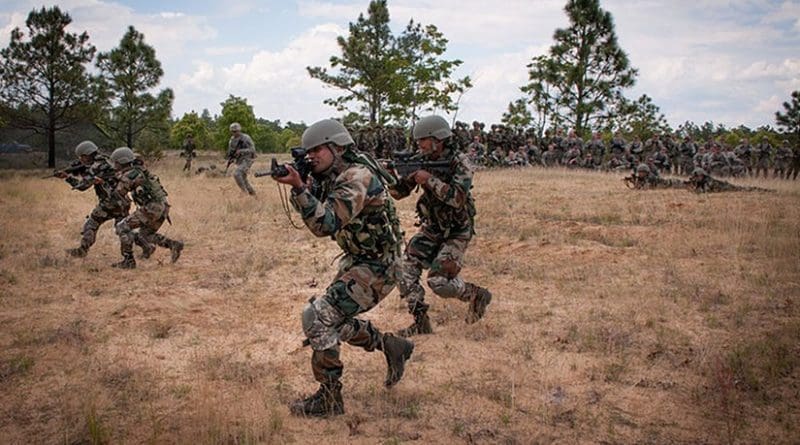Tiger Triumph: US-India Military Relations Get More Complex – Analysis
By Observer Research Foundation
A new exercise has reinforced the trend of deepening defense collaboration between the two sides.
By Rajeswari Pillai Rajagopalan*
The Indian and US militaries are engaged in their maiden joint tri-services humanitarian assistance and disaster relief (HADR) exercise, which they are calling “Tiger Triumph,” in Visakhapatnam and Kakinada in the southern Indian state of Andhra Pradesh. This represents an improvement over the type of joint military exercises that the two countries have held to date, and is an indication that defense relations between the two sides are steadily deepening.
The U.S. and Indian militaries have been engaged in a number of different military exercises since the early 1990s, including Yudh Abhyas and Vajra Prahar (army), Malabar and RIMPAC (multilateral, navy) and Red Flag (air force). This followed the big boost to U.S.-India defense relations with the Kicklighter proposals in 1991, which included service-to-service exchanges between India and the United States.
The first India-U.S. military exercise codenamed “Teak Iroquois” took place between the two armies in February 1992; the first naval exercise named Malabar-I in May 1992. In addition to generating interoperability, these exercises have been great familiarization opportunities for the two militaries to understand each other’s strategic and security perspectives. With each iteration, these exercises have grown in terms of the number of personnel and platforms involved, and the exercises themselves have become much more complex and useful.
This week, we saw another indication of the increasing complexity of U.S.-India exercises with the holding of Tiger Triumph, the maiden tri-service HADR exercise. The exercises, which started on November 13, should last a week. It is taking place on the India’s eastern seaboard with the participation of all three Indian services along with the U.S. Navy and Marines.
Indian naval ships Jalashwa, Airavat, and Sandhayak; Indian Army troops from 19 Madras and 7 Guards; and Indian Air Force MI-17 helicopters and Rapid Action Medical Team (IAF-RAMT) are participating in it from the Indian side. The United States has sent the USS Germantown and troops from the U.S. 3rd Marine Division. The U.S. Marine Corps Forces, Pacific, is leading the efforts on the U.S. side. There are a total of 1,200 Indian and 500 U.S. men and women from different services participating in the first-ever U.S.-India tri-service exercise.
The exercise, focused on HADR aspects, is meant to be an annual event from now on, bolstering the already-strong military-to-military collaboration between India and the United States.
The exercise is aimed at building and nurturing better and more effective interoperability between the services of the two militaries. It is because the two militaries have held specific service-led military exercises for more than a decade that the Indian and the U.S. militaries were able to respond to the 2005 Indian Ocean tsunami in a prompt and coordinated fashion. Interoperability is the mantra, especially for a region that is characterized by a high number of natural disasters on a fairly periodic basis to which multiple countries respond.
According to an Indian government press release, the exercise will begin with a Harbor Phase at Vishakapatnam, which will be followed by a Sea Phase conducted in Kakinanda, where “the landing of Relief Forces would be undertaken to the Exercise scenario.” A Joint Command and Control Centre will be established by the Indian Army and U.S. Marines. The HADR area will also have a medical facility camp, established by the IAF-RAMT and the U.S. Navy Medical team, that will cater to the “victims” who would have been shifted to the facility by air and road. The exercise, with a goal of helping capacity-building for both the militaries, will simulate a full scenario involving field training and moving humanitarian assistance and disaster relief from ship to shore. The exercise will end with a closing ceremony on board the U.S. naval vessel Germantown on November 21.Beyond Tiger Triumph itself, the trend of the increasing complexity of U.S.-India exercises is rooted in broader strategic dynamics. These exercises are the result of the growing convergence between American and Indian strategic interests with the changing strategic dynamics in the Indo-Pacific and beyond. In this context, there is a recognition on both sides that more capable powers such as India and the United States have to join forces to prevent the possibility of a hegemonic Asia.
This has manifested itself in how both sides have been talking about each other within their broader strategic approaches. There have been repeated assertions from the United States on the importance of India in their Indo-Pacific strategy, and this is asserted in the U.S. National Security Strategy document as well as the U.S. Department of Defense’s 2019 Indo-Pacific Strategy Report. India does not bring out formal, official strategy papers, but statements by senior government officials and the upgrading of the Quad talks to ministerial level are a demonstration of similar sentiments on the Indian side too. And the idea of a free, open, and inclusive Indo-Pacific was reiterated by Prime Minister Narendra Modi at the Shangri La Dialogue in 2018.
Engagements such as Tiger Triumph are also a demonstration of the fact that despite the occasional irritants in the relationship, U.S.-India ties are still deepening amid these wider strategic dynamics.
This article originally appeared in The Diplomat

